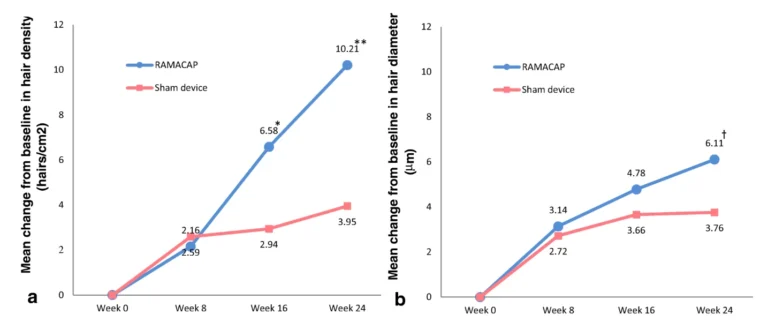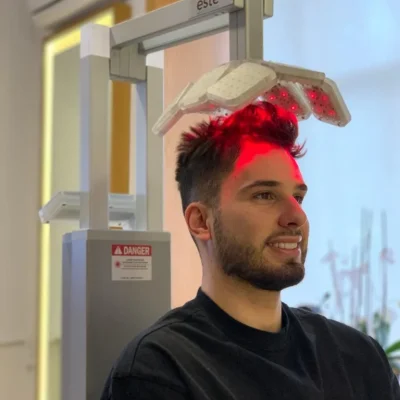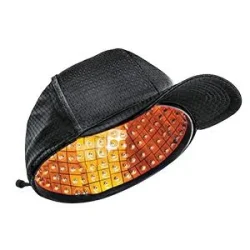How Low-Level Laser (LLLT) Works, Results, Usage, and Side Effects
Hair loss, or androgenetic alopecia (AGA), remains a major concern for individuals globally, impacting self-esteem and socio-psychological well-being. Among the various innovative interventions, low-level laser therapy (LLLT) has been postulated as a potential non-invasive remedy for hair loss. This article explores the scientific principles underpinning LLLT’s mechanism of action, its therapeutic potential, and reviews key studies delineating its efficacy.
What is Low-Level Laser Therapy (LLLT)?
Low-Level Laser Therapy (LLLT) actively manages hair loss through an innovative and non-invasive approach. Firstly, this therapy utilizes specialized low-level laser or light-emitting diode (LED) devices to emit specific wavelengths of light directly onto the scalp. Furthermore, LLLT’s potential benefits include stimulating hair follicles, subsequently increasing blood circulation in the scalp, and moreover, enhancing cellular activity within the hair follicles. This combination of effects potentially halts hair loss and encourages hair regrowth. Additionally, LLLT is often integrated into comprehensive hair restoration strategies. It can be administered either at home or in clinical settings, employing devices like laser combs, helmets, or caps. Although individual results may vary, LLLT is widely recognized and accepted as a safe and painless option for those seeking solutions to hair loss.
History of Low-Level Laser Therapy (LLLT)
The history of Low-Level Laser Therapy (LLLT) for hair loss can be traced back to the mid-20th century when scientists initiated exploration into the potential medical applications of lasers. The idea of utilizing low-level lasers to stimulate tissue regeneration and hair growth gained momentum during the 1960s and 1970s.
In a significant development in 1967, Hungarian physician Endre Mester conducted experiments involving low-level lasers on mice, initially with the intention of studying their effects on tumors. However, to his surprise, the laser light led to the stimulation of hair growth in the treated areas. This serendipitous discovery marked the pioneering phase of LLLT for hair restoration.
Over subsequent decades, researchers conducted numerous studies aimed at gaining a deeper understanding of how LLLT precisely triggers hair growth. Their findings highlighted that the laser light activates cells within the hair follicles, fostering increased blood circulation and enhanced cellular activity. This cascade of events promotes the anagen (growth) phase of hair follicles, potentially counteracting hair loss.
The early 2000s saw a surge in the utilization of LLLT in hair restoration, coinciding with the development of portable devices like laser combs and helmets. These innovations made it possible for individuals to undergo LLLT treatments within the comfort of their own homes, significantly enhancing accessibility. As a result, LLLT has become a favored supplementary treatment choice for those looking to address hair thinning and stimulate hair regrowth. While its effectiveness may vary among individuals, its non-invasive nature and minimal side effects have contributed to its widespread adoption within the realm of hair restoration. Ongoing research endeavors aim to further refine LLLT protocols and broaden our comprehension of its efficacy in managing hair loss.
How Low-Level Laser Therapy (LLLT) Treats Hair Loss
Low-Level Laser Therapy (LLLT) is a non-invasive treatment for hair loss that uses low-level laser or light-emitting diode (LED) devices to stimulate hair follicles. While the exact mechanisms are not fully understood, several theories explain how LLLT can promote hair growth:
- Increased Blood Circulation
- LLLT devices emit low-level laser or LED light directly onto the scalp. This light is absorbed by the cells in the hair follicles and stimulates microcirculation, increasing blood flow to the follicles. Improved blood circulation can deliver more nutrients and oxygen to the hair follicles, enhancing their function and promoting hair growth.
- Activation of Cellular Metabolism
- LLLT may activate and energize the cells within the hair follicles, improving their metabolic processes. This increased cellular activity can extend the anagen (growth) phase of the hair follicles and shorten the telogen (resting) phase, leading to thicker and healthier hair.
- Reduction of Inflammation
- Inflammation in the scalp can disrupt the normal hair growth cycle and contribute to hair loss. LLLT has been suggested to reduce inflammation in the scalp, helping to create a more favorable environment for hair regrowth.
- Enhancement of ATP Production
- LLLT may stimulate the production of adenosine triphosphate (ATP), which provides energy to cells. Increased ATP production can enhance the function of hair follicle cells, leading to improved hair growth.
- Protection against Miniaturization
- In conditions like androgenetic alopecia, hair follicles gradually miniaturize and produce thinner, weaker hair. LLLT has been proposed to help protect against this miniaturization, resulting in thicker and healthier hair.
- Promotion of Hair Follicle Proliferation
- LLLT may encourage the proliferation of hair follicle cells, leading to increased hair density.
Empirical Evidence
- Gentile et al. (2015) conducted a study on 23 patients, administering PRP injections. The results showcased a significant increase in hair density and the caliber of the hair shaft, demonstrating the treatment’s efficacy.
- Cervelli et al. (2014) explored the synergistic effects of PRP combined with hair transplant in 48 patients. Findings indicated a quicker post-transplant recovery and a higher survival rate of the transplanted follicles in the PRP-treated group.
- Alves and Grimalt (2018) undertook a systematic review of multiple clinical trials on PRP for AGA. The majority of these studies manifested improvements in hair density, thickness, and overall patient satisfaction post-treatment.

Clinical trials showing an increase in hair density and hair diameter after using LLLT compared to a placebo device.
Results
The results of Low-Level Laser Therapy (LLLT) for hair loss can vary from person to person, and not everyone will experience the same level of success. However, many individuals have reported positive outcomes when using LLLT for hair loss. Here are some of the potential results and benefits associated with LLLT:
- Increased Hair Density: LLLT can stimulate existing hair follicles, leading to increased hair density in areas affected by thinning or hair loss. This means that the hair may appear thicker and fuller over time.
- Improved Hair Quality: Some individuals notice an improvement in the quality of their hair, with increased strength and resilience. LLLT may also lead to a reduction in hair breakage.
- Slower Hair Loss Progression: LLLT may help slow down the progression of hair loss, particularly in conditions like androgenetic alopecia (male and female pattern baldness). It can extend the anagen (growth) phase of hair follicles, delaying their transition to the telogen (resting) phase.
- Enhanced Hair Regrowth: LLLT has the potential to stimulate dormant or inactive hair follicles, leading to the regrowth of hair in areas where it has been lost.
- Increased Self-Confidence: For individuals experiencing hair loss, the visible improvements in hair density and quality resulting from LLLT can boost self-esteem and confidence.
- Minimal Side Effects: LLLT is generally considered safe and well-tolerated, with few reported side effects. This makes it an attractive option for individuals seeking non-invasive hair loss treatments.

Improved hair growth and density after continued use of low-level laser therapy (LLLT).
Low-Level Laser Therapy (LLLT) Procedure
Low-Level Laser Therapy (LLLT) for hair loss is a non-invasive procedure that involves the use of low-level laser or light-emitting diode (LED) devices to stimulate hair follicles and promote hair growth. The procedure typically follows these steps:
- Device Selection: Patients can choose from various LLLT devices available on the market. These devices come in different forms, such as laser caps, laser helmets, laser combs, and laser bands. Each device has its specifications, including the number of diodes or LEDs and the recommended treatment time.
- Preparation: Before using an LLLT device, it’s important to prepare the scalp. This involves ensuring the scalp is clean and free from hair products or oils. Cleanliness helps enhance the penetration of laser or LED light into the scalp.
- Device Placement: Place the selected LLLT device on the head, ensuring that the light-emitting elements are positioned to cover the areas of the scalp affected by hair loss. The device should fit comfortably and securely on the head.
- Treatment Duration: The duration of LLLT treatment sessions can vary depending on the device and manufacturer’s recommendations. Some devices require as little as a few minutes per session, while others may recommend longer treatment times, such as 20 to 30 minutes. Patients should follow the specific guidelines provided by the device manufacturer.
Safety and Side Effects
Low-Level Laser Therapy (LLLT) for hair loss is generally considered a safe and well-tolerated treatment option with minimal side effects. However, some individuals may experience minor side effects, although these are relatively rare and mild. Here are potential side effects associated with LLLT for hair loss:
- Scalp Irritation: Some people may experience mild scalp irritation or itching during or after LLLT treatment sessions. This irritation is usually temporary and can often be alleviated by adjusting the treatment settings or using a lower power setting.
- Tenderness: In rare cases, individuals may report scalp tenderness or sensitivity following LLLT sessions. This discomfort is usually mild and short-lived, resolving on its own.
- Dryness or Flakiness: A few people might notice mild dryness or flakiness of the scalp as a side effect of LLLT. Proper scalp hygiene and moisturizing can help manage this issue.
- Temporary Shedding: Some users may experience a temporary increase in hair shedding during the initial weeks of LLLT treatment. This is known as “shedding phase” and can be a sign that dormant hair follicles are transitioning to the growth phase. This shedding is usually followed by regrowth of new, healthier hair.
- Eye Sensitivity: LLLT devices emit laser or LED light, and it’s important to protect your eyes during treatment to prevent potential eye discomfort or sensitivity. Follow the device’s instructions regarding eye protection measures.
Conclusion
The intersection of photobiomodulation and hair restoration has paved the way for LLLT’s emergence as a potential beacon of hope for those grappling with hair loss. Its mechanisms, anchored in cellular revitalization, ROS mitigation, and improved microcirculation, create a fertile ground for hair rejuvenation.
References:
- Kim, H., et al. (2007). The effects of long-term, near-infrared laser irradiation on chronic hair pulling in mice. Laser Therapy, 16(3), 143-147.
- Leavitt, M., et al. (2009). HairMax LaserComb laser phototherapy device in the treatment of male androgenetic alopecia: A randomized, double-blind, sham device-controlled, multicentre trial. Clinical Drug Investigation, 29(5), 283-292.
- Gupta, A. K., & Daigle, D. (2014). The use of low-level light therapy in the treatment of androgenetic alopecia and female pattern hair loss. Journal of Dermatological Treatment, 25(2), 162-163.
Note: Always seek professional medical advice before starting any treatment.


